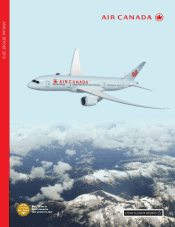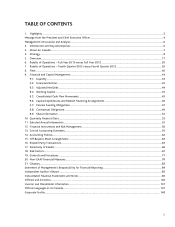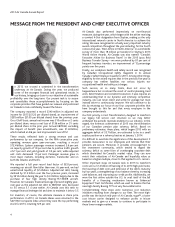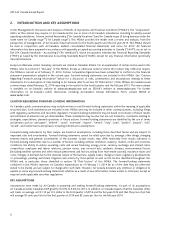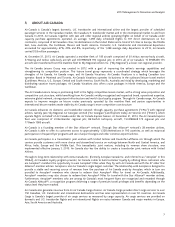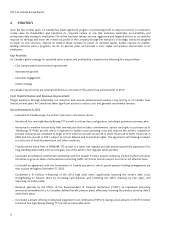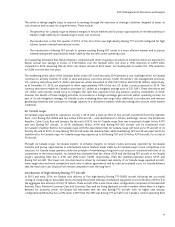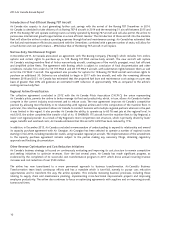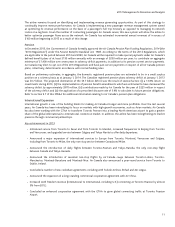Air Canada 2013 Annual Report Download - page 9
Download and view the complete annual report
Please find page 9 of the 2013 Air Canada annual report below. You can navigate through the pages in the report by either clicking on the pages listed below, or by using the keyword search tool below to find specific information within the annual report.2013 Management’s Discussion and Analysis
9
The airline is taking tangible steps to improve its earnings through the execution of strategic initiatives designed to lower its
cost structure and increase its competitiveness. These include:
• The growth of Air Canada rouge to enhance margins in leisure markets and to pursue opportunities in international leisure
markets made viable by Air Canada rouge’s lower cost structure.
• The introduction, in the first quarter of 2014, of the last of five new high-density Boeing 777 aircraft configured for high
volume, leisure-oriented international routes.
• The introduction of Boeing 787 aircraft to operate existing Boeing 767 routes in a more efficient manner and to pursue
international growth opportunities made viable by this aircraft’s lower operating costs.
Air Canada has estimated that these initiatives, combined with other on-going cost reduction initiatives which are expected to
deliver annual cost savings in excess of $100 million over the medium term, will drive a 15% reduction in CASM when
compared to 2012, assuming that all other cost drivers remain at 2012 levels. Air Canada plans to realize this 15% reduction
in CASM over the next five years.
The weakening in the value of the Canadian dollar in late 2013 and into early 2014 presents a cost challenge which Air Canada
continues to actively monitor in order to seek and pursue corrective actions. Under the airline’s risk management practices,
U.S. currency derivatives and U.S. dollar cash reserves, which amounted to US$1,547 million and US$743 million, respectively,
as at December 31, 2013, are employed to offset approximately 50% of the net U.S. dollar currency exposure in 2014. The
currency derivatives enable Air Canada to purchase U.S. dollars at a weighted average price of C$1.0341. These derivatives and
U.S. dollar cash reserves would serve to mitigate the cash flow exposure from any adverse currency movements in 2014;
however the benefit of these hedging activities is recorded as a foreign exchange gain and not within operating income. As
part of its risk mitigation strategy, Air Canada is also evaluating fares and cargo rates, additional cost reduction and revenue
generating initiatives and continues to manage capacity in a disciplined manner, while also taking into account other market
conditions.
Air Canada rouge
Air Canada rouge launched its operations on July 1, 2013 with a start-up fleet of four aircraft transferred from the mainline
fleet – two Boeing 767-300ER and two Airbus A319 aircraft – with destinations to Athens, Edinburgh, Venice, the Dominican
Republic, Cuba, Costa Rica and Jamaica. By the end of 2013, the Air Canada rouge fleet was comprised of eight Airbus A319
and two Boeing 767 aircraft. In 2014, additional Airbus A319 and Boeing 767-300 aircraft will be transferred from
Air Canada’s mainline fleet to Air Canada rouge, with the expectation that Air Canada rouge will have up to 33 aircraft in its
fleet by the end of 2014. As new Boeing 787 aircraft enter the mainline fleet, additional Boeing 767 aircraft are expected to be
transferred to Air Canada rouge. Air Canada rouge may operate up to 20 Boeing 767 and 30 Airbus A319 aircraft, for a total of
50 aircraft.
Through Air Canada rouge, Air Canada expects to enhance margins on leisure routes previously operated by Air Canada
mainline and pursue opportunities in international leisure markets made viable by Air Canada rouge’s more competitive cost
structure. Air Canada rouge operates under the principle of maintaining a long-term cost structure consistent with that of its
competitors in the leisure market. Air Canada has estimated that the Airbus A319 and the Boeing 767 aircraft in Air Canada
rouge’s operating fleet has a 21% and 29% lower CASM, respectively, than the mainline-operated Airbus A319 and
Boeing 767 aircraft. This lower cost structure level is driven by increased seat density of Air Canada rouge-operated aircraft,
lower wage rates and more competitive work rules in labour agreements, and by reduced overhead costs. Air Canada believes
that the new lower cost structure will remain competitive over the long-term.
Introduction of High-Density Boeing 777 Aircraft
In 2013 and early 2014, Air Canada took delivery of five high-density Boeing 777-300ER aircraft following the successful
closing of a financing on favourable terms involving the private offering of enhanced equipment trust certificates (“EETCs”) in
the aggregate face amount of US$715 million. These aircraft offer a new three-cabin configuration comprised of International
Business Class, Premium Economy Class and Economy Class and are being deployed on select markets where there is a higher
demand for economy travel. Air Canada has estimated that the new Boeing 777 aircraft, with its higher seat density
configuration (458 seats), has a 21% lower CASM than the 349-seat Boeing 777 aircraft in Air Canada’s current operating fleet.

